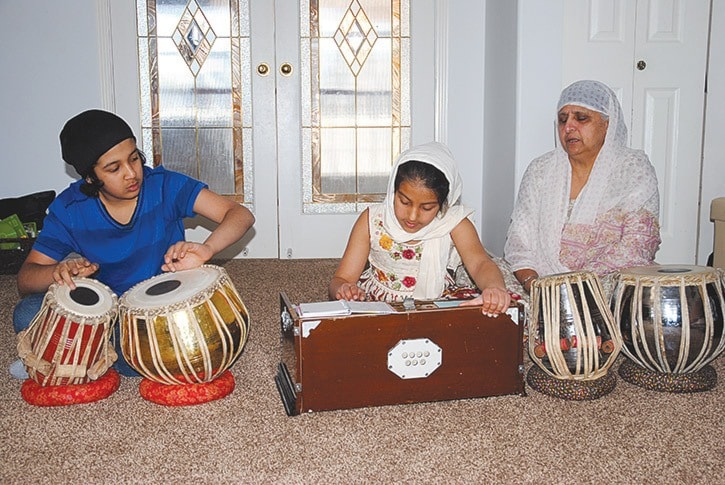Music plays an integral part in the devotional services of most religions around the world.
In the Sikh religion there are more than 4,000 holy songs, says Amerjit Shergill.
She says that about 1,400 of the traditional songs are contained in the pages of the Sikh holy book Guru Granth Sahib.
Amerjit learned the Sikh musical traditions from her father, the late Darshan Sing.
Her daughter, Harjit Shergill (she kept her own last name) learned the music working with both her mother and grandfather.
Now Harjit’s children, Priya, 9, and Mokam, 12, Mahil practice regularly with their grandmother and play periodically with other children and adults Guru Nanak and Gurdwara Western Singh Sabha temples in Williams Lake and at a temple in Quesnel. Traditionally Amerjit says the women play the Baja, a form of harmonium and the men play a drum called a Tabla.
The harmonium operates similarly to an accordion except that it is a box-style instrument with the keyboard in front and the bellows in back. The left hand pumps the bellows while the right hand plays the keys.
Amerjit teaches Priya the Baja. Mokam studies the Tabla with a priest and his son in Quesnel where Amerjit and her husband, Harban, live.
Priya and Mokam learn their songs from a little book written in Punjabi.
The songs can be written in English but Amerjit is teaching them to read and learn the songs in the traditional Punjabi language.
The songs they are learning are holy songs called Shabad, which praise the Lord.
Harjit says she and her brothers were raised in the Sikh tradition, but their parents gave them the option of deciding at age 18 whether they wanted to be baptized.
She says she and her siblings chose not to become baptized because baptism can become limiting. However, she says two of her brothers carry on the Sikh traditions as if they were baptized.
She says baptized Sikhs never cut their hair and must pray in the morning and in the evening.
Baptized Sikhs also wear traditional Sikh dress which includes head coverings for both men and women, modest underwear, a circular bracelet, a small comb in the hair, and a sword or small dagger called a kirpan.
Young baptized girls and boys wear a scarf on their heads called a batka and women wear a head covering called a kaski, Amerjit says.
Baptized men and women also wear a traditional suit which includes pants and a long tunic.
Harjit says she never cut her hair until she was 18.
She decided not to become baptized because it would restrict her work opportunities.
She has been working as an accountant for nine years and has one course left before becoming a registered Certified General Accountant.
Over the years she has worked in accounting for government and for School District 27.
Two years ago she took a job in private industry with Pinnacle Pellet, which she says is rounding out her accountancy skills.
She kept her own name when she married, and is working to make sure her children are also well rounded, which is why she is encouraging them to learn more about their traditions as as well as enjoy a wide variety of activities.
Priya was in French immersion for the first couple of years of her schooling and is now in regular classes and taking gymnastics.
She is also very artistic and enjoys learning to knit, sew, and to cook traditional dishes such as samosas.
Over spring break Priya made a knitted doll. Last spring break she attended a Sikh camp in New Westminister where the children enjoyed a variety of crafts and sporting activities along with the teachings of Khalsa.
Mokam enjoys a wide variety of sports including basketball, volleyball, floor hockey, soccer, and skiing.
As a family they also enjoy skiing, fishing with their First Nations friends and camping.
E-mail helps the family stay connected. Each morning Harjit receives a prayer from her cousin called a Hukumnama which comes directly from the Golden Temple in India and serves as a spiritual guide for the day.
Because of her busy schedule, Harjit says she doesn’t usually see the prayer until the evening but she finds receiving them to be an uplifting experience, especially as the family is recovering from the recent loss of Harjit’s husband, Barinder Mahil, who passed away in January.
Her father in law Baldev Mahil and her parents are also providing the family with support during this period of grief.
Over spring break Harjit made a unique tribute wall to Barinder in their entrance using an old door.
Every time they hang up their coats the family sees pictures in the windows of the door which is hung sideways on the wall and features dozens of family pictures in the window spaces and loving messages to their lost husband, father, and son around the edges, with coat hooks along the bottom.
Harjit also takes a turn reading the Sikh holy book Guru Granth Sahib during the annual Vaisakhi Day celebrations which take place in April. She says the family has friends at both the Guru Nanak and Gurdwara Western Singh Sabha temples in Williams Lake and the temple in Quesnel.
Reading of the holy book starts on the Friday morning of the weekend the celebrations are planned and continues uninterrupted through until about noon on the Sunday morning.
Members of the congregation take turns reading for up to two hours at a time.
Harjit says reading the holy book is a bit like reading Shakespeare.
It takes a bit of study to understand everything that is being said and the reading is more expressive for her where she has more understanding.
She says experienced readers will also have a rhythmic lilt to their reading where the songs are located in the book.
